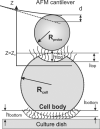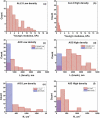AFM study shows prominent physical changes in elasticity and pericellular layer in human acute leukemic cells due to inadequate cell-cell communication
- PMID: 27834315
- PMCID: PMC5221648
- DOI: 10.1088/0957-4484/27/49/494005
AFM study shows prominent physical changes in elasticity and pericellular layer in human acute leukemic cells due to inadequate cell-cell communication
Abstract
Biomechanical properties of single cells in vitro or ex vivo and their pericellular interfaces have recently attracted a lot of attention as a potential biophysical (and possibly prognostic) marker of various diseases and cell abnormalities. At the same time, the influence of the cell environment on the biomechanical properties of cells is not well studied. Here we use atomic force microscopy to demonstrate that cell-cell communication can have a profound effect on both cell elasticity and its pericellular coat. A human pre-B p190BCR/ABL acute lymphoblastic leukemia cell line (ALL3) was used in this study. Assuming that cell-cell communication is inversely proportional to the distance between cells, we study ALL3 cells in vitro growing at different cell densities. ALL3 cells demonstrate a clear density dependent behavior. These cells grow very well if started at a relatively high cell density (HD, >2 × 105 cells ml-1) and are poised to grow at low cell density (LD, <1 × 104 cells ml-1). Here we observe ∼6× increase in the elastic (Young's) modulus of the cell body and ∼3.6× decrease in the pericellular brush length of LD cells compared to HD ALL3 cells. The difference observed in the elastic modulus is much larger than typically reported for pathologically transformed cells. Thus, cell-cell communication must be taken into account when studying biomechanics of cells, in particular, correlating cell phenotype and its biophysical properties.
Figures





Similar articles
-
Defective quorum sensing of acute lymphoblastic leukemic cells: evidence of collective behavior of leukemic populations as semi-autonomous aberrant ecosystems.Am J Cancer Res. 2016 Jun 1;6(6):1177-230. eCollection 2016. Am J Cancer Res. 2016. PMID: 27429840 Free PMC article.
-
Mechanical Way To Study Molecular Structure of Pericellular Layer.ACS Appl Mater Interfaces. 2023 Aug 2;15(30):35962-35972. doi: 10.1021/acsami.3c06341. Epub 2023 Jul 25. ACS Appl Mater Interfaces. 2023. PMID: 37489588 Free PMC article.
-
AFM Indentation Analysis of Cells to Study Cell Mechanics and Pericellular Coat.Methods Mol Biol. 2018;1814:449-468. doi: 10.1007/978-1-4939-8591-3_27. Methods Mol Biol. 2018. PMID: 29956249
-
Load Rate and Temperature Dependent Mechanical Properties of the Cortical Neuron and Its Pericellular Layer Measured by Atomic Force Microscopy.Langmuir. 2016 Feb 2;32(4):1111-9. doi: 10.1021/acs.langmuir.5b04317. Epub 2016 Jan 19. Langmuir. 2016. PMID: 26727545
-
Method for quantitative measurements of the elastic modulus of biological cells in AFM indentation experiments.Methods. 2013 Apr 1;60(2):202-13. doi: 10.1016/j.ymeth.2013.03.037. Epub 2013 Apr 30. Methods. 2013. PMID: 23639869 Review.
Cited by
-
Regional biomechanical imaging of liver cancer cells.J Cancer. 2019 Jul 25;10(19):4481-4487. doi: 10.7150/jca.32985. eCollection 2019. J Cancer. 2019. PMID: 31528212 Free PMC article.
-
Atomic force microscopy for revealing micro/nanoscale mechanics in tumor metastasis: from single cells to microenvironmental cues.Acta Pharmacol Sin. 2021 Mar;42(3):323-339. doi: 10.1038/s41401-020-0494-3. Epub 2020 Aug 17. Acta Pharmacol Sin. 2021. PMID: 32807839 Free PMC article. Review.
-
AFM-based detection of glycocalyx degradation and endothelial stiffening in the db/db mouse model of diabetes.Sci Rep. 2017 Nov 21;7(1):15951. doi: 10.1038/s41598-017-16179-7. Sci Rep. 2017. PMID: 29162916 Free PMC article.
-
Detection of Human Bladder Epithelial Cancerous Cells with Atomic Force Microscopy and Machine Learning.Cells. 2024 Dec 26;14(1):14. doi: 10.3390/cells14010014. Cells. 2024. PMID: 39791715 Free PMC article.
-
Selective ultrasound contrast enhancement in the tumor by nanocapsules with perfluorooctylbromide: effect of PLGA-PEG proportion.RSC Adv. 2018 May 16;8(32):17958-17966. doi: 10.1039/c8ra01824c. eCollection 2018 May 14. RSC Adv. 2018. PMID: 35542111 Free PMC article.
References
-
- Suresh S, Spatz J, Mills JP, Micoulet A, Dao M, Lim CT, Beil M, Seufferlein T. Connections between single-cell biomechanics and human disease states: gastrointestinal cancer and malaria. Acta Biomater. 2005;1:15–30. - PubMed
-
- Binnig G, Quate CF, Gerber C. Atomic force microscope. Phys. Rev. Lett. 1986;56:930–3. - PubMed
MeSH terms
Grants and funding
LinkOut - more resources
Full Text Sources
Other Literature Sources
Research Materials
Miscellaneous
